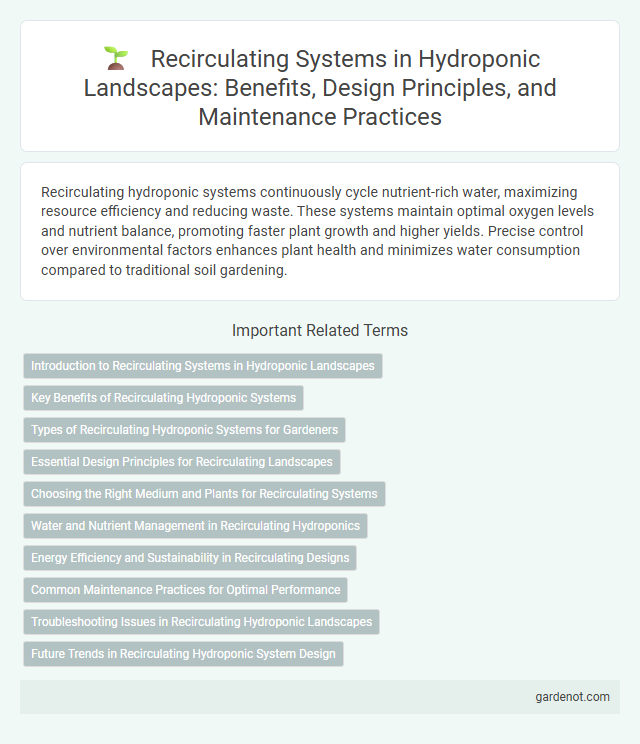Recirculating hydroponic systems continuously cycle nutrient-rich water, maximizing resource efficiency and reducing waste. These systems maintain optimal oxygen levels and nutrient balance, promoting faster plant growth and higher yields. Precise control over environmental factors enhances plant health and minimizes water consumption compared to traditional soil gardening.
Introduction to Recirculating Systems in Hydroponic Landscapes
Recirculating systems in hydroponic landscapes continuously recycle nutrient-rich water, optimizing resource efficiency and reducing waste. This closed-loop method maintains consistent nutrient levels and pH balance, promoting healthier plant growth and higher yields. Advanced sensors and automated controls further enhance precision, minimizing water consumption and environmental impact.
Key Benefits of Recirculating Hydroponic Systems
Recirculating hydroponic systems efficiently reuse nutrient solutions, reducing water consumption by up to 90% compared to traditional soil methods. These systems maintain optimal nutrient levels and pH balance, promoting faster plant growth and higher yields. Enhanced resource management in hydroponic landscapes minimizes waste and operational costs, supporting sustainable and scalable agricultural practices.
Types of Recirculating Hydroponic Systems for Gardeners
Recirculating hydroponic systems primarily include Nutrient Film Technique (NFT), Deep Water Culture (DWC), and Aeroponics, each offering unique advantages for efficient nutrient and water usage in garden settings. NFT circulates a thin film of nutrient solution over plant roots, promoting oxygen access and rapid growth, while DWC submerges roots in oxygenated nutrient-rich water for maximum nutrient absorption. Aeroponics suspends roots in air and mists them with nutrient solution, enhancing oxygen availability and accelerating plant development.
Essential Design Principles for Recirculating Landscapes
Recirculating hydroponic landscapes require precise water flow and aeration management to maintain nutrient balance and oxygen levels. Designing efficient pump systems and filtration units ensures consistent circulation and prevents clogging, critical for plant health and system longevity. Optimal sizing of reservoirs and piping minimizes waste and supports stable environmental conditions essential for thriving plant growth.
Choosing the Right Medium and Plants for Recirculating Systems
Selecting the right growing medium and plants is crucial for optimizing hydroponic recirculating systems. Inert mediums such as expanded clay pellets, rock wool, or coconut coir provide excellent aeration and moisture retention, promoting healthy root development and nutrient absorption. Ideal plants for recirculating systems include leafy greens like lettuce and herbs such as basil and mint, which thrive in consistent nutrient flow and stable moisture conditions.
Water and Nutrient Management in Recirculating Hydroponics
Recirculating hydroponic systems optimize water and nutrient management by continuously cycling nutrient-rich solutions through plant roots, significantly reducing water usage compared to traditional methods. Precise control of nutrient concentration, pH levels, and oxygenation within the reservoir ensures optimal plant growth and prevents nutrient imbalances or toxicities. Advanced monitoring technologies enable real-time adjustments, enhancing system efficiency and promoting sustainable, high-yield hydroponic landscapes.
Energy Efficiency and Sustainability in Recirculating Designs
Recirculating hydroponic systems optimize energy efficiency by continuously reusing nutrient solutions, reducing water and fertilizer consumption by up to 90% compared to traditional methods. These designs incorporate energy-saving pumps and smart sensors that adjust flow rates and nutrient delivery based on real-time plant needs, minimizing waste and carbon footprint. Sustainable materials like recycled plastics and renewable energy sources further enhance the environmental benefits of recirculating hydroponic landscapes.
Common Maintenance Practices for Optimal Performance
Regularly inspecting and cleaning pumps, filters, and nutrient tanks in recirculating hydroponic systems prevents blockages and equipment failure. Monitoring pH and nutrient levels ensures plant health and nutrient uptake efficiency in the circulating solution. Flushing the system periodically reduces salt buildup, maintaining optimal water quality and system longevity.
Troubleshooting Issues in Recirculating Hydroponic Landscapes
Common issues in recirculating hydroponic landscapes include nutrient imbalances, root rot, and pump failures that disrupt constant water flow. Regular monitoring of pH levels, nutrient concentration, and oxygenation helps prevent plant stress and poor growth. Implementing routine maintenance protocols for pumps and filters reduces downtime and maintains system efficiency.
Future Trends in Recirculating Hydroponic System Design
Future trends in recirculating hydroponic system design emphasize enhanced water-use efficiency through advanced sensor integration and AI-driven nutrient management. Innovations in modular, scalable units enable customizable growth environments, optimizing plant health and yield while minimizing resource consumption. Sustainable materials and automated cleaning technologies are increasingly adopted to reduce environmental impact and maintenance costs in large-scale hydroponic landscapes.
Recirculating system Infographic

 gardenot.com
gardenot.com